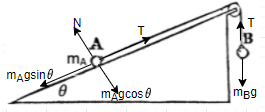4. Consider an inclined plane with two balls suspended as shown below. The pulley has negligible mass and both the pulley and the surface of the incline are frictionless. The balls remain motionless. a.Draw and label a free body diagram (FBD) for each ball. (Don't forget to label the acceleration info. Also, don't break any B forces into components for the FBDS–save that work for the next mB question. Finally, be sure to use the gridlines to help you draw arrows that show the correct directions and relative magnitudes of the forces.) A MA C Ball A: Ball B: b. If < 45°, rank the relative sizes of the magnitudes of all forces in both FBDS: (I'm looking for a single ranking that includes every different force in both FBDS, separated by <, >, or =.) Use the FBDS above, and Newton's 2nd Law, to calculate an expression for the mass of ball A if iť's going to keep ball B suspended motionless next to the ramp. (Use the back of this page if you need more room to show your work.) c. ma = d. Which ball has more mass? (Circle one, and justify your answer using math or physics.) A В
4. Consider an inclined plane with two balls suspended as shown below. The pulley has negligible mass and both the pulley and the surface of the incline are frictionless. The balls remain motionless. a.Draw and label a free body diagram (FBD) for each ball. (Don't forget to label the acceleration info. Also, don't break any B forces into components for the FBDS–save that work for the next mB question. Finally, be sure to use the gridlines to help you draw arrows that show the correct directions and relative magnitudes of the forces.) A MA C Ball A: Ball B: b. If < 45°, rank the relative sizes of the magnitudes of all forces in both FBDS: (I'm looking for a single ranking that includes every different force in both FBDS, separated by <, >, or =.) Use the FBDS above, and Newton's 2nd Law, to calculate an expression for the mass of ball A if iť's going to keep ball B suspended motionless next to the ramp. (Use the back of this page if you need more room to show your work.) c. ma = d. Which ball has more mass? (Circle one, and justify your answer using math or physics.) A В
Related questions
Question
100%

Transcribed Image Text:4. Consider an inclined plane with two balls suspended as shown below. The pulley has negligible mass and
both the pulley and the surface of the incline are frictionless. The balls remain motionless.
a.Draw and label a free body diagram (FBD) for each ball.
(Don't forget to label the acceleration info. Also, don't break any
A
MA C
forces into components for the FBDS–save that work for the next
question. Finally, be sure to use the gridlines to help you draw
arrows that show the correct directions and relative magnitudes of
the forces.)
mB
Ball A:
Ball B:
b. If < 45°, rank the relative sizes of the magnitudes of all forces in both FBDS:
(I'm looking for a single ranking that includes every different force in both FBDS, separated by <, >, or =.)
Use the FBDS above, and Newton's 2nd Law, to calculate an expression for the mass of ball A if it's
going to keep ball B suspended motionless next to the ramp. (Use the back of this page if you need more
room to show your work.)
с.
m4 =
d. Which ball has more mass? (Circle one, and justify your answer using math or physics.)
A
В
Expert Solution
Step 1
(a) Refer to the free-body diagrams of both the masses below :


Here, T is tension in the rope, N is the normal force acting on A.
(b) Refer to the figure below :
 (Breaking the components of mAg)
(Breaking the components of mAg)
As the system is in equilibrium, the tension in the rope is :
The normal force acting on A is :
Step by step
Solved in 2 steps with 3 images
